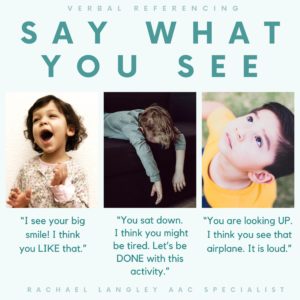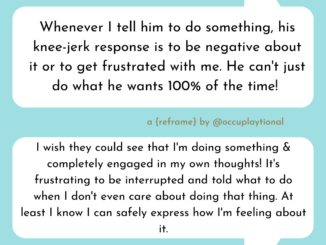
[Image description:
There is a title at the top of the meme that reads “Verbal Referencing: Say What You See”.
Three images of toddlers are shown, with captions beneath them.
The first child is smiling with an open-mouthed smile. The caption says, “I see your big smile! I think you LIKE that.”
The second child is draped across the back of a couch. The caption says, “You sat down. I think you might be tired. Let’s be DONE with this activity.”
The third child is looking up with an intense concentration on their face. The caption says, “You are looking UP. I think you see that airplane. It is loud.”
The image was made by Rachael Langley, AAC Specialist.
End description.]
Naming what we think might be going on for our children gives them the foundations of language to be able to describe their own experiences later on!
For young children, like 0-2, narrating exactly like described in this meme is super helpful and models for them how to express themselves later.
As children get older, like 3-5, the exact type of narration may be helpful or it may not. Some more verbal children may get frustrated by it, or outright tell you that you’re narrating their experience wrong. (“I not sad, I MAD!”) Some children with less ability to speak for themselves may still get frustrated, but not quite be able to tell you why. Sometimes this type of narration can feel demeaning, like you’re talking down to them, or like you’re incorrectly labeling their experience.
Even if your child doesn’t have the ability to fully express what it is they’re feeling, it’s okay to “say what you see” in a way that feels right for you and them. Maybe instead of speaking declaratively, as though you are the authority on their experience, you sort of “muse out loud” instead.
Also, you can pair a factual statement about what you observe in them, with a reflective statement about what you feel in yourself, for a narration that’s sometimes less threatening. For example, instead of saying, “You sat down. I think you might be tired,” (to which a 3-5 year old who’s working on developing autonomy might either say or just think, “nuh-UH!!! I’m not TIRED!!!!”), you might say, “You sat down. I’m going to sit down too—I feel tired!”



